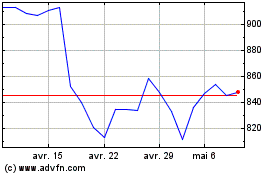Europe's Most Valuable Tech Company Can Help the Chip Shortage--Heard on the Street
21 Avril 2021 - 5:09PM
Dow Jones News
By Stephen Wilmot
Good news for anyone looking for a new car: The microchip
industry is mustering faster than expected to solve today's
crippling shortages.
ASML, which competes with Applied Materials to sell
semiconductor-manufacturing gear to the likes of Intel and Taiwan
Semiconductor Manufacturing, on Wednesday more than doubled its
growth forecast for the year and said it was increasing production
capacity for 2022 -- a reassuring sign for any business that needs
chips to make its products and any consumer waiting for them. The
stock jumped 4%.
The Dutch manufacturer has grown to become Europe's most
valuable technology company, with a market value of $257 billion.
That compares to just $118 billion for Applied Materials, even
though the U.S. company has slightly higher revenue. One reason is
ASML's near-monopolistic position in a cutting-edge chip-making
technology called extreme ultraviolet (EUV) lithography. Intel's
new chief executive, Pat Gelsinger, last month said the company
erred in not embracing EUV earlier.
ASML's EUV revenue will grow 30% this year -- that hasn't
changed -- but it is working with its supply chain to ramp up
output for next year ahead of its previous plans. The company also
said it was looking at boosting capacity in more standard deep
ultraviolet (DUV) lithography. Given that the current shortage
seems to be affecting basic chips as much as advanced ones,
concrete steps here would be welcome.
That said, ASML's DUV business will manage nicely this year with
just existing capacity. Following big capital-spending
announcements by TSMC, Intel and Samsung, the company expects to
increase revenues by 30% in 2021, led by DUV machines. Its previous
guidance implied growth of around 12%. Meanwhile, ASML's
first-quarter results were boosted by a more immediate response to
the shortage as chipmakers bought software upgrades that increase
the output of existing machines.
At 47 times prospective earnings, ASML is an expensive stock,
both relative to peers and its own record. One question hanging
over that valuation is geopolitical. CEO Peter Wennink sees ASML as
a potential beneficiary of the "capital inefficiency" that might
result from greater U.S. autonomy in chip manufacturing. Yet China
accounted for 15% of ASML's first-quarter revenue -- business that
is vulnerable to U.S. moves to limit Chinese access to cutting-edge
chip technology.
The nosebleed valuation might deter stockpickers, but it is in
part an expression of confidence in ASML's ability to help fix the
great chip shortage.
Write to Stephen Wilmot at stephen.wilmot@wsj.com
(END) Dow Jones Newswires
April 21, 2021 10:54 ET (14:54 GMT)
Copyright (c) 2021 Dow Jones & Company, Inc.
ASML Holding NV (EU:ASML)
Graphique Historique de l'Action
De Mar 2024 à Avr 2024

ASML Holding NV (EU:ASML)
Graphique Historique de l'Action
De Avr 2023 à Avr 2024
